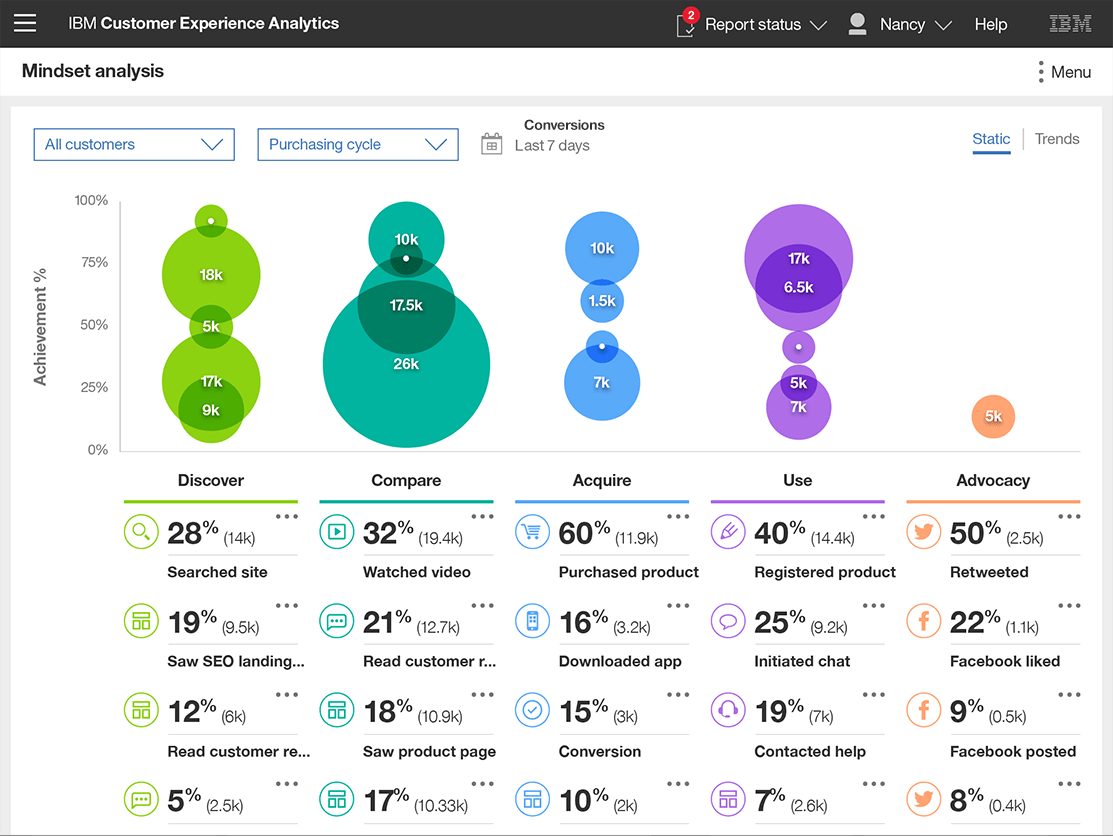IBM rolls out many new roles for its Watson supercomputing service
They include solutions for marketing and commerce, an intelligent chatbot builder, integration with iOS apps, and video analysis.

IBM’s supercomputer Watson is adding many new capabilities to its resume, following a truckload of announcements this week.
There are new packages of services for specific industries, including marketing, commerce, supply chain management, and HR, adding to previously-released solutions for financial services, regulatory compliance, and education. There’s also a new service for building and launching virtual agents, and another for intelligent analysis of video.
The marketing solution includes two new services:
- Content Hub employs cognitive intelligence to understand what’s in content management systems, enabling it to learn from previous examples how to automatically tag text, images, and videos.
- Customer Experience Analytics utilizes such behavioral patterns as shopping history to dynamically update customer segmentation via simulations and natural language interaction with marketers.

The solution for commerce offers:
- The Order Optimizer, which learns from past history and makes recommendations about factors affecting order fulfillment, such as shipping costs.
And for supply chain professionals, there’s:
- Supply Chain Insights, that similarly learns from past data so it can make recommendations that might save costs by minimizing delays.
Watson Virtual Agent allows businesses to simplify the building and launching of conversational chatbots in social media, SMS, mobile and embedded tech, using pre-trained industry content. Staples, for instance, has been using Virtual Agent to power a supply ordering bot across platforms.
And the IBM-owned Weather Channel, which has recently employed Watson’s intelligence for its ad targeting platform and for Watson Ads, announced a Watson-powered “cognitive weather bot” for Facebook Messenger. It is designed to learn users’ preferences for delivering weather info through a natural language interface.
MobileFirst for iOS is intended specifically for use in travel, retail, and financial services. It integrates Watson services, including natural language processing, into apps for Apple’s iOS.
Watson for Cloud Video analyzes live and recorded video to track audience reaction through an analysis of concurrent social media. IBM notes this could be used, for instance, to gauge reaction to a video transmission of a new product launch even before the presenting speaker has left the stage.
In addition, this service builds on Watson’s earlier experiments with pulling shots for a movie trailer to automatically divide videos into scenes. IBM gives some possible uses:
“For example, the service could automatically create chapters of video clips based on different topics in a lecture, instructions for different cooking recipes or house-hunting scenes for individual neighborhoods. This level of detail would normally require a person to watch and manually categorize every piece of the video.”
https://www.youtube.com/watch?v=D1NqItGaqIQ
And the Watson Data Platform offers the “world’s fastest data ingestion engine” to facilitate drag-and-drop analytical services, including machine learning.
Also, GM has announced OnStar Go, offering yet another Watson use for marketers. It provides a version of its OnStar car communication system that allows Watson’s navigation, diagnostics, and other services to learn from drivers’ behavior in order to deliver personalized offers from partners like Exxon Mobile.
Watson utilizes aggregated, anonymous data from all its clients to feed its growing wisdom, IBM Watson Commerce Insights Director Melody Dunn told me, although a specific client’s data is the focus. She also pointed out that, while Watson’s many services have tie-ins to specific IBM platforms, they are available as standalones. A business might use the Content Hub or Customer Experience Analytics with, say, Adobe’s or Salesforce’s marketing clouds.
I asked her if the increasingly intelligent Watson ever surprised her. She recalled being surprised when Watson automatically tagged an image of a bike, with a plant in the foreground, in the Content Hub. It correctly identified the bike, but there was also a strange name included. It turned out to be the scientific name for the plant.
(Updated 6:52pm ET, 10.26.16, with comments from IBM.)
Contributing authors are invited to create content for MarTech and are chosen for their expertise and contribution to the search community. Our contributors work under the oversight of the editorial staff and contributions are checked for quality and relevance to our readers. MarTech is owned by Semrush. Contributor was not asked to make any direct or indirect mentions of Semrush. The opinions they express are their own.
Related stories
New on MarTech